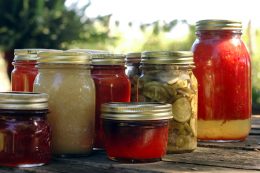 This week I went to a 4-H Foods Judging Training. I learned a lot about the proper way to judge food and food preservation at fairs, along with how to can safely at home. I thought I would share some of the 10 tips for safe home-canned foods. If you would like the rest, visit our office for the publication!
This week I went to a 4-H Foods Judging Training. I learned a lot about the proper way to judge food and food preservation at fairs, along with how to can safely at home. I thought I would share some of the 10 tips for safe home-canned foods. If you would like the rest, visit our office for the publication!
- Altitude Adjustment – here in Harvey County we need to adjust for altitude. Our altitude is 1,000 – 1,500 feet and some parts are higher depending on where you are in the County. This means we need to add time or pressure to our canned goods.
- Untested or Homemade Recipes – are a big no, no! If you are using a recipe that is older than 1994, then you need to find a new one. All caning recipes have been meticulously tested with research and science to prove that it will kill any bacteria and heat completely through. If you are needed to find a new recipe, please come see me, I have plenty of recipes.
- Processing Equipment – make sure you are using the correct methods on how to process your canned goods. Open kettle canning, canning using the dishwasher or ovens are not safe! They do not work the same as water bath canning and pressure canning. If you do anything other than the two safe methods, then you risk food spoiling and foodborne illness.
- Acidifying Tomatoes – tomatoes are on the borderline between low acid and high acid food. Therefore you need to add some type of acid in with them. That can be lemon juice, citric acid or vinegar that is 5%.
- Headspace – is very important. During processing times or storage times, you canned goods can expand, or shrink. If they expand you will not have enough liquid for your canned good and risk color changes and food spoilage. Also it can seep underneath the lid and cause it to unseal.
There are 10 tips total, if you would like to know the rest, contact me at aelpers@ksu.edu or at 316-284-6930. Happy Canning!
